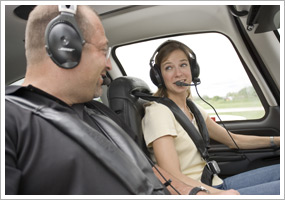Custom content for the Sept. 16, 2011, issue of 'AOPA ePilot: Flight Training Edition' newsletter
| The following stories from the Sept. 16, 2011, edition of AOPA ePilot were provided to AOPA members who expressed an interest in the particular subject areas. Any AOPA member can receive information tailored to their areas of interest by updating their preferences online |
training tipsSupervision and safety In the definition of passengers we can also include nonflying pilots who have been delegated supporting roles, or who have offered to do them. Your flight instructor makes a good surrogate for a passenger until you earn your sport, recreational, or private pilot certificate. Develop the habit of overseeing the performance of any preflight chores that your instructor offers to perform before dual flights. Don’t let the fact that he or she has more experience than you prevent you from making sure that the CFI has secured a fuel cap or the oil dipstick, or remembered to lock the baggage compartment as promised. Lack of clarity over who possesses command authority for a flight has caused numerous mishaps. A related precaution—and this too you can take directly away from your training—is to have a clear method worked out for positive transfer of control for the day when you are flying as a certificated pilot, and you ask a certificated-pilot passenger to take over momentarily on the controls. On checkrides, designated examiners are likely to scrutinize the contents and delivery of an applicant’s passenger briefing. (They have also been known to leave a lap belt or shoulder harness unfastened to see if you catch the lapse before takeoff.) Briefing your passengers or their surrogates should include explaining that you will adopt a best practice known as a sterile cockpit during workload-intensive phases of flight. It will also be up to you to practice what you preach, which may require your enforcement of the policy if it is unwittingly violated by other occupants. Safety around propellers is of paramount importance—and that’s when you may have to take responsibility for the well-being of strangers on the ramp. Errors of omission in this area have led to numerous accidents. Review the Air Safety Institute’s Propeller Safety Safety Advisor. Who’s responsible if precautions and safety procedures are overlooked? The pilot in command. Earning your pilot certificate warrants that you are up to the task—with all its complex human factors! training productsMyClip Thigh iPad holder from WicksWhen was the last time a product spawned so many companion products? New from Wicks is another gadget to hold your Apple iPad in place while you fly. The MyClip Thigh from Wicks utilizes clips that let you secure the iPad to your leg and position it in either portrait or landscape mode. The device costs $32.50 and may be ordered online.
Note: Products listed have not been evaluated by ePilot editors unless otherwise noted. AOPA assumes no responsibility for products or services listed or for claims or actions by manufacturers or vendors. final exam
Question: I just completed my private pilot training in a single-engine land airplane. Can I now act as pilot in command of any single-engine land airplane?
Answer: Yes, provided you also have any required endorsements. For example, tailwheel, complex, and high-performance airplanes as well as aircraft capable of operating at high altitudes require further training in order for you to act as pilot in command if your initial flight training did not include it. To prove that you have received the appropriate training in these kinds of aircraft, you need to obtain and log ground and flight training and receive a logbook endorsement from an authorized instructor. For further information on these and other endorsements and their requirements, read FAR 61.31. Also see AOPA's aviation subject reports on ratings and endorsements and transitioning to high-performance aircraft.
Got a question for our technical services staff? E-mail [email protected] or call the Pilot Information Center, 800/872-2672. Don’t forget the online archive of “Final Exam” questions and answers, searchable by keyword or topic. |
 One of a pilot in command’s most important, but sometimes least tangible, duties is that of supervision. Passengers, line-service technicians, and even total strangers on the ramp must be taken into consideration before, during, and after a flight.
One of a pilot in command’s most important, but sometimes least tangible, duties is that of supervision. Passengers, line-service technicians, and even total strangers on the ramp must be taken into consideration before, during, and after a flight.

